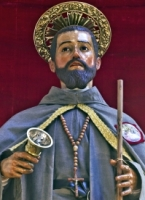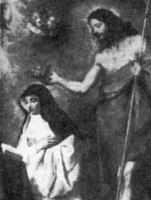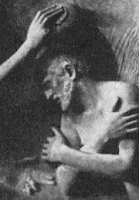Saint Zita of Lucca
லூக்கா நகர் புனிதர் ஸிட்டா
(St. Zita of Lucca)
கன்னியர்:
(Virgin)
பிறப்பு: கி.பி. 1212
லூக்கா நகரின் அருகேயுள்ள மொன்ஸக்ரட்டி, இத்தாலி
(Monsagrati, Near Lucca, Italy)
இறப்பு: ஏப்ரல் 27, 1272 (வயது 59-60)
லூக்கா, இத்தாலி
(Lucca, Italy)
ஏற்கும் சமயம்:
ரோமன் கத்தோலிக்க திருச்சபை
(Roman Catholic Church)
புனிதர் பட்டம்: கி.பி. 1696
முக்கிய திருத்தலம்:
சேன் ஃப்ரேடியானோ பேராலயம், லூக்கா
(Basilica di San Frediano, Lucca)
நினைவுத் திருநாள்: ஏப்ரல் 27
பாதுகாவல்:
வீட்டுப் பணியாளர்கள், தொலைந்துபோன சாவி,
பாலியல் வன்முரைக்காளானவர்கள், தமது பக்திக்காக இழிவுபடுத்தப்பட்ட மக்கள்,
திருச்சபையின் திருமணமாகாத பொதுநிலைப் பெண்கள் (Single Laywomen), லூக்கா எனும் இத்தாலிய நகரம் (Italian City of Lucca)
புனிதர் ஸிட்டா ஒரு இத்தாலிய நாட்டு ரோமன் கத்தோலிக்க புனிதரும், அருட்சகோதரியும் ஆவார்.
இத்தாலியின் லூக்கா (Lucca) நகரின் அருகேயுள்ள "மோன்சக்ரட்டி" (Monsagrati) என்னும் கிராமத்தில் பிறந்த இவர், தமது பன்னிரெண்டாம் வயதிலேயே வீட்டுப் பணிப்பெண்ணாக பணியமர்த்தப்பட்டார். நீண்ட காலமாக அவர் ஒரு பணிப்பெண்ணாக கொடுமைப்படுத்தப்பட்டார். கடினமான பணிகள் அவர்மேல் சுமத்தப்பட்டன. நியாயமற்ற முறையில் அவர் துன்புறுத்தப்பட்டார். அவருடைய அன்பான மற்றும் வெளிப்படையான தன்மைக்காக அவர் அவரது முதலாளிகளாலும், சக பணியாளர்களாலும் தாக்கப்பட்டார். இடைவிடாது தவறாகப் பயன்படுத்தப்பட்டார். அவருடைய பணிவும், சாந்த குணமும், அன்பும் அவரைக் கொடுமைப் படுத்திய முதலாளிகளையும், சக பணியாளர்களையும் அவரை விட்டு விலக வைத்தன. அவரது விடாமுயற்சியும், பண்பும் அவரை அவர்களிடமிருந்து மீட்டன. அவரது நிலையான பக்தி படிப்படியாக ஒரு மத எழுச்சியை குடியேற்றியது.
சோம்பேறித்தனமான பக்தி பொய்மையானது என்று அவர் அடிக்கடி பிறருக்கு எடுத்துரைத்தார். அவருக்கு தரப்பட்ட பணி, கடவுளால் அவருக்கு தரப்பட்டது என்று கூறினார். பிறரை இகழ்வதை விட்டு, தமது பணிகளை தாமே செவ்வன செய்தார். உறங்கும் நேரத்தைக் குறைத்து, செபத்தில் ஈடுபட்டார்.
கி.பி. 1272ம் ஆண்டு, ஏப்ரல் மாதம், 27ம் நாளன்று, அவர் உறக்கத்திலேய சமாதானமாக இறந்தார். அவர் படுத்திருந்த இடத்தின்மேலே ஒரு விண்மீன் தோன்றியதாக சொல்லப்பட்டது.
அடக்கம் செய்யப்பட்ட அவரது உடல், கி.பி. 1580ம் ஆண்டு தோண்டி வெளியில் எடுக்கப்பட்டது. அவரது உடல் கெட்டு விடாத நிலையில் கண்டுபிடிக்கப்பட்டது. ஆனால் பின்னர் பதப்படுத்தப்பட்டதாக மாறிவிட்டது. புனிதர் ஸிட்டாவின் உடல் தற்போது லுக்காவிலுள்ள 'சேன் ஃப்ரேடியானோ பேராலயத்தில்' (Basilica di San Frediano in Lucca) பொதுமக்கள் பார்வைக்காக வைக்கப்பட்டுள்ளது.
Also known as<
Cita, Sita, Citha, Sitha
Profile
Born to a very poor but pious family. At age twelve she became a domestic servant for the wealthy Fainelli family in Lucca, Italy, a position she kept all her life; she looked at it as a way to serve God. She often gave her own food, and sometimes that of her master, to those poorer than herself, which caused her to get in frequent trouble with her employers and the other servants in the house who resented her. However, she did such a fine job she was eventually placed in charge of the house, and entrusted with its keys. Attended daily Mass before beginning her duties, and would go to a nearby monastery to pray in private. Her reputation was such that Dante in the Inferno referred to the city of Lucca as “Santa Zita”.
Born
1218 at Bozzanello, Monte Sagrate, Tuscany, Italy
Died
• 27 April 1272 at Lucca, Italy of natural causes
• buried in the church of San Frediano in Lucca
• her tomb was re-discovered in 1580
Beatified
• 1652 by Pope Innocent X
• during the recognition proceedings, her remains were found to be incorrupt
Canonized
• the office in her honour approved by Pope Leo X
• 5 September 1696 by Pope Innocent XII (cultus confirmed)
• added to the Roman Martyrology in 1748 by Pope Benedict XIV
Patronage
• against losing keys
• butlers
• domestic servants (proclaimed by Pope Pius XII)
• homemakers
• housemaids
• lost keys
• maids
• manservants
• people ridiculed for their piety
• rape victims
• servants
• servers
• single laywomen
• waiters, waitstaff, waitresses
• Lucca, Italy
Blessed Hosanna of Cattaro
Also known as
• Catherine Cosie
• Catherine Kosic
• Catherine of Montenegro
• Hosanna of Kotor
• Ossana of Cattaro
• Ozana Kotorska
• Teacher of Mysticism
• Trumpet of the Holy Spirit
Profile
Born to Greek Orthodox parents, and baptized in that tradition. She was a shepherdess in her youth, spending her solitary hours in prayer, and began to have visions of the Christ child. When she was 12 years old, the visions were followed by an odd desire to travel to the town of Cattaro, Dalmatia (modern Kotor, Montenegro) where she felt she could pray better. Her mother arranged a position for Catherine as a servant to a wealthy Catholic woman who allowed the girl as much time as she wished for church visits. In Cattaro, Catherine converted to Roman Catholicism.
In her late teens she felt a call to live the hard, spiritual life of an anchoress. Though she was very young for such a calling, her spiritual director had her a walled up cell built near Saint Bartholomew's church in Cattaro. She later moved to a cell at Saint Paul's church, and became a Dominican tertiary, taking the name Osanna in memory of Blessed Osanna of Mantua; she would follow the Dominican rule for the next 52 years. A group of Dominican sisters took up residence near her, consulted her for guidance, sought her prayers, and considered her their leader; there were so many that a Dominican convent was founded for them.
In her tiny cell she received many visions including the Christ as a baby, Our Lady, several saints, and demons who opposed her prayer life. Satan appeared once in the guise of Mary; she knew it was the devil when the vision tried to get her to give up the religious life. When the city was attacked by the Turks, the towns people credited their deliverance to her prayers. Tradition says that her prayers saved the city from the plague.
Born
25 November 1493 at Kumano, Montenegro as Catherine Cosie
Died
• 27 April 1565 in Kotor, Montenegro of natural causes
• interred in the Church of Saint Paul, Kotor, Montenegro
• remains moved to the Church of Saint Mary in Kotor, Montenegro in 1807 after the French army turned the Church of Saint Paul into a warehouse
Beatified
• 21 December 1927 by Pope Pius XI (cultus confirmed)
• 1934 by Pope Pius XI (beatified)
Patronage
Kotor, Montenegro
Blessed Jakov Varingez
Also known as
• Giacomo de Bitetto
• Giacomo of Bitetto
• Giacomo Varingez
• Giacomo Veringuez
• James of Bitetto
• James of Dalmatia
• James of Illyricum
• James of Sclavonia
• James of Zara
• James the Illyrian
• James the Slav
Additional Memorial
20 April (Franciscans)
Profile
Son of Leonardo and Beatrice Varingez. Jakov re-located to Bari, Italy to escape Turkish invaders. There he felt a call to religious life and joined the Order of Friars Minor at the friary of Bitetto, Italy; he lived there nearly all the rest of his life. He served as cook, alms-beggar, gardener, porter, and sacristan. Known for being continually in prayer, he was given to ecstasies, noted as a miracle worker and for the ability to levitate. In his 80's he worked with victims of the plague of 1482.
Born
c.1400 in Zadar, Zadarska, Croatia
Died
• 27 April 1496 in Bitetto, Bari, Italy
• body incorrupt about 20 years after his burial, and parts of the body are still so today
Beatified
• 29 December 1700 by Pope Clement XI (cultus confirmation)
• 19 December 2009 by Pope Benedict XVI (decree of heroic virtues)
Blessed Peter Armengol
Also known as
• Pere Ermengol
• Peter Armengaudius
• Peter Ermengol
• Pietro Armengaudio
Profile
Born to the nobility, Pietro wasted his youth in dissolute living, and rode for a while as a brigand and thief. His band once tried to hijack his father‘s entourage, which caused the young man to re-evaluate his life. He had a conversion, and joined the Mercedarians in 1258.
From that point on he worked tirelessly to ransom hostages. Personally took the place of 18 captured Christian children. and endured enough torture for the entire group, including being hanged until his tormenters thought he was dead. He survived the experience and retired to the convent of Saint Mary of the Meadows, but it, and the life of pain he led as a result of the torture, led to his being considered a martyr.
Born
1238 at Tarragona, Urgell region, eastern Spanish Pyrenees
Died
1304 at Tarragona, Urgell region, eastern Spanish Pyrenees of natural causes
Beatified
28 March 1686 by Pope Innocent XI (cultus confirmed)
Blessed Nicolas Roland
Profile
Raised in a pious family. Educated by Jesuits. Canon of Rheims, France while still a seminarian. Priest. Noted preacher. Assigned as parish priest in Rouen, France. Returned to Rheims with the plan to start schools for poor girls; he took a run-down orphanage and turned it into a successful school for orphaned and abandoned girls. Founder of the Soeurs de l'Enfant-Jésus (Sisters of the Infant Jesus) whose first members were teachers at his school; they received formal approval on 9 May 1678. He and the Sisters expanded the work and founded more schools around the city. Friend and mentor of Saint John Baptist la Salle who continued Nicolas' work by supervising the Sisters, and later founding schools for boys.
Born
8 December 1642 in Rheims, Marne, France
Died
• 27 April 1678 in Rheims, Marne, France of natural causes
• interred in the crypt of the Sisters of the Child Jesus in Rheims
Beatified
16 October 1994 by Pope John Paul II
Saint John of Kathara
Also known as
• John di Catari
• John of Cathares
• John of Constantinople
Profile
Entered a monastery at age nine. Attended the Second Council of Nicaea in 787. Ordained at the Dalmatus monastery in Constantinople. Hegumen (abbot) of the Kathara monastery in Bithynia (in modern Turkey) in 805. Removed from his office, beaten and sent into exile in 815 for opposing the iconoclasm of emperor Leo V. Worked with Saint Theodore the Stoudite to defend icons. Brought to Constantinople in 817, both the emperor and the patriarch tried to convince him to support the iconoclasts; he refused and was exiled again. He was allowed to return to his house in late 820, but was exiled again in 832 when the iconoclasts came to power again.
Born
Irenopolis, Isaurian Decapolis
Died
c.835 on the prison island of Aphousia (modern Avsa, Balikesir, Turkey) of natural causes
Saint Adelelmus of Le Mans
Also known as
• Adelelmus of Etival
• Adelelmus of Flanders
• Adelermus, Adelhelm, Adelinus, Alleaume, Adelelmo, Adelermo, Adelino
Profile
Friend and spiritual student of a hermit named Albert around Le Mans, France. Spiritual student of Saint Bernard of Tiron on Chaussey in the Channel Islands, but he returned to live as a hermit with Albert. With help from the count of Beaumont, Adelelmus founded a monastery for monks in the forest of Charnier, and a convent in Etival-a-Charnier in 1109. Though he lived near, and helped teach monks and nuns, Adelelmus apparently took any vows or joined any religious order.
Born
Flanders, Belgium
Died
27 April 1152 of natural causes
Saint Maughold
Also known as
• Apostle of the Isle of Man
• Macaille, Macaldus, Macallius, Macc Cuill, Maccaldus, Maccul, Machalus, Machaoi, Machella, Macull, Maghor, Maguil, Mawgan, Morgan, Mauchold
Profile
Prince, pirate and thief. Converted to Christianity by Saint Patrick. To avoid temptation, he set sail from Ireland in a wicker boat, letting God set his course. He landed on the Isle of Man where he served as missionary bishop. Some versions say that Patrick ordained him, and assigned him to the Isle of Man as penance for his earlier life. Many geographic features on the Isle still bear his name. Legend says he divided the island into parishes, but it is unlikely.
Died
c.488
Patronage
Isle of Man
Saint Liberalis of Treviso
Also known as
• Liberalis of Altino
• Liberale of...
Profile
Priest. Worked to convert Arians to orthodox Christianity, and was much abused by the Arians because of it. Late in life he retired to live as a hermit on a small island.
Born
near Ancona, Italy
Died
• c.400
• relics brought to Treviso, Italy in 452 by parishioners fleeing invading Huns
Patronage
• Castelfranco Veneto, Italy
• Treviso, Italy
Saint Laurensô Nguyen Van Huong
Also known as
Lawrence, Lorenzo
Additional Memorial
24 November as one of the Martyrs of Vietnam
Profile
Priest of the apostolic vicariate of West Tonkin (in modern Vietnam). Arrested as he was visiting a dying man during the persecutions of Emperor Tu-Duc; he was ordered to trample a cross; he refused. Flogged and executed. Martyr.
Born
c.1802 in Ke Sài, Hanoi, Vietnam
Died
beheaded on 27 April 1856 in Ninh Bình, Vietnam
Canonized
19 June 1988 by Pope John Paul II
Saint Asicus of Elphin
Also known as
Ascicus, Asic, Assic, Assicus, Tassach
Profile
Married coppersmith and silversmith. Convert. Disciple of Saint Patrick. First bishop of the diocese of Elphin, Ireland. Late in life, citing his unworthiness to lead his parishioners, he retired to live as a prayerful hermit on an island in Donegal Bay; monks from his diocese followed and tried to get him to return.
Died
c.490 of natural causes at Racoon, Donegal, Ireland
Canonized
19 June 1902 by Pope Leo XIII (cultus confirmed)
Patronage
diocese of Elphin, Ireland
Saint Theodore of Tabenna
Also known as
• Theodore of Tabennísi
• Theodor, Theodoros
Additional Memorial
16 May (Eastern calendar)
Profile
Monk at age 14. Spiritual student of Saint Pachomius at the monastery in Tabenna, Egypt; Pachomius delegated Theodore to bury him in secret. Chosen abbot of Tabenna in 350. Founded several monasteries in Egypt. Miracle worker.
Born
c.314 in Isna, Egypt
Died
27 April 368 of natural causes
Saint Floribert of Liège
Also known as
Florbert, Floribertus, Florebartus, Floriberius, Florebertus
Additional Memorial
1 November in the Diocese of Liege, Belgium
Profile
Son of Saint Hubert of Liege and Floribana of Louvain; his mother died in child-birth. Bishop of Liege, Belgium.
Born
685 in France
Died
• 25 April 746 of natural causes
• buried in the Cathedral of Saint Lambert
Blessed Joseph Outhay Phongphumi
Profile
Layman catechist in the apostolic vicariate of Savannakhet (in modern Laos). Martyr.
Born
1933 in Kham Koem, Nakhon Phanom, Thailand
Died
27 April 1961 in Muang Phalane, Savannakhet, Laos
Beatified
• 11 December 2016 by Pope Francis
• beatification recognition celebrated in Vientiane, Laos, presided by Cardinal Angelo Amato
Saint Pollio of Cybalae
Also known as
• Pollio of Cibala
• Pollio of Cibali
• Pollio of Cibalis
• Pollio of Vinkovci
Additional Memorial
28 April (Hieronymian Martyrology; Synaxary of Constantinople)
Profile
Lector of the church of Cybalae in Pannonia. Martyred in the persecutions of Diocletian for refusing to sacrifice to idols.
Died
burned alive c.304 in Cybalae, Pannonia (modern Vinkovci, Croatia)
Blessed Umberto di Miribel
Also known as
Umberto of Valence
Profile
Carthusian monk. Prior of the Charterhouse of Silve-Bénite, France. Bishop of Valencia, Spain in 1200. The law at that time made the bishop the civil governor of the city, which caused his time as bishop to be filled with political conflicts with the local nobility.
Died
27 April 1220 of natural causes
Blessed Noël Tenaud
Profile
Member of the Paris Foreign Missions Society. Priest. Martyr.
Born
11 November 1904 in Rocheservière, Vendée, France
Died
27 April 1961 in Muang Phalane, Savannakhet, Laos
Beatified
• 11 December 2016 by Pope Francis
• beatification recognition celebrated in Vientiane, Laos, presided by Cardinal Angelo Amato
Saint Simeon of Jerusalem
Also known as
Simeon, Simon
Profile
Son of Cleophas and related to Jesus. Second bishop of Jerusalem. Tortured and executed in the persecutions of Trajan. Martyr.
Died
crucified c.107
Blessed Bartolomeo da Vittoria
Also known as
Bartolomeo da Vadinia
Profile
A 15th–16th century Franciscan friar known as a humble man with a deep prayer life and the gift of prophecy.
Died
1512 at the convent of Santa Maria del Gesù in Saragozza, Spain of natural causes
Saint Palladius I of Bourges
Also known as
Palladio
Profile
Born to a family of imperial Roman senatorial rank, Palladius became bishop of Bourges (in modern France) in the latter 4th century.
Saint Enoder
Also known as
Cynidr, Keneder, Kenedr, Quidic
Profile
Grandson of Saint Brychan of Brecknock. The towns of Llangynidr, Wales, Saint Enoder, Cornwall and Kenderchurch, England are named for him.
Died
6th century
Saint Damaride
Profile
Martyr. No other information has survived.
Died
• Rome, Italy, date unknown
• buried in the catacombs
• relics enshrined in Palo del Colle, Italy
Saint Tertullian of Bologna
Profile
Eighth bishop of Bologna, Italy, serving during the collapse of the western Roman Empire.
Died
c.490
Saint Stephen of Tarsus
Profile
Martyred in one of the early persecutions in Asia Minor.
Died
at Tarsus, Cilicia, Asia Minor
Saint Castor of Tarsus
Profile
Martyred in one of the early persecutions in Asia Minor.
Died
at Tarsus, Cilicia, Asia Minor
Saint Winewald of Beverley
Profile
Abbot of Beverley Abbey in England.
Died
c.731
Saint Theophilus of Brescia
Profile
Bishop of Brescia, Italy.
Died
c.427
Martyrs of Nicomedia
Profile
A group of Christians murdered together for their faith. In most cases all we have are their names - Dioscurus, Evanthia, Felicia, Felix, Germana, Germelina, Johannes, Julius, Laetissima, Nikeforus, Papias, Serapion and Victorinus.
Died
at Nicomedia, Bithynia, Asia Minor (modern Izmit, Turkey)































